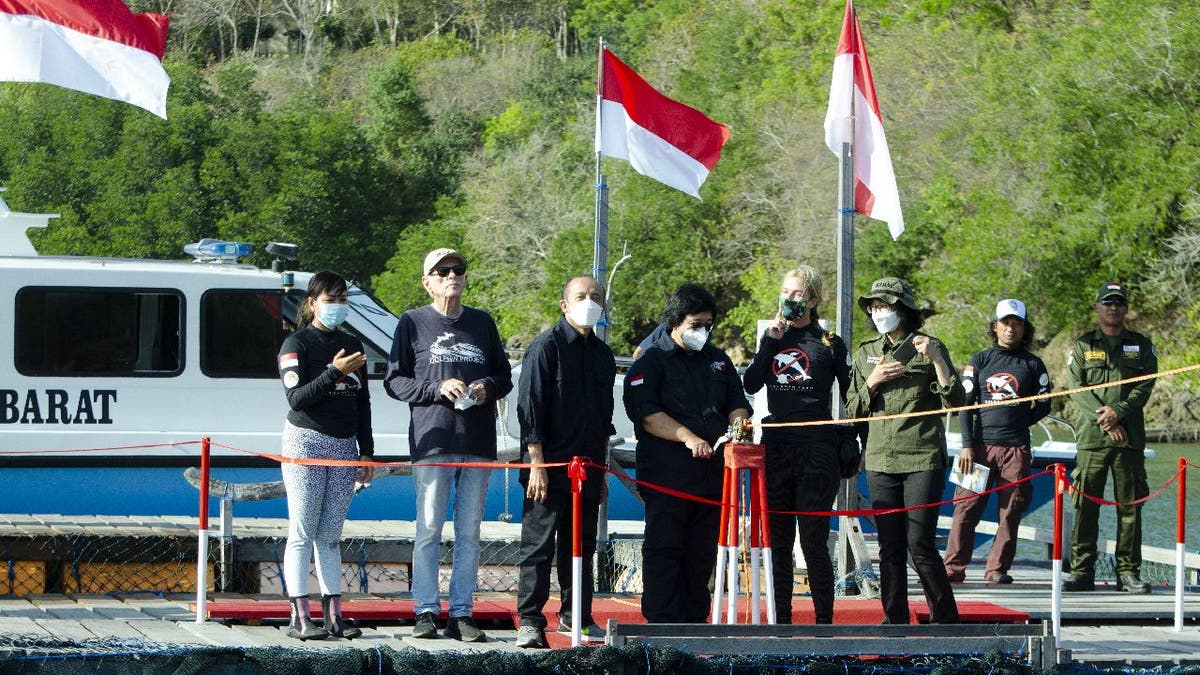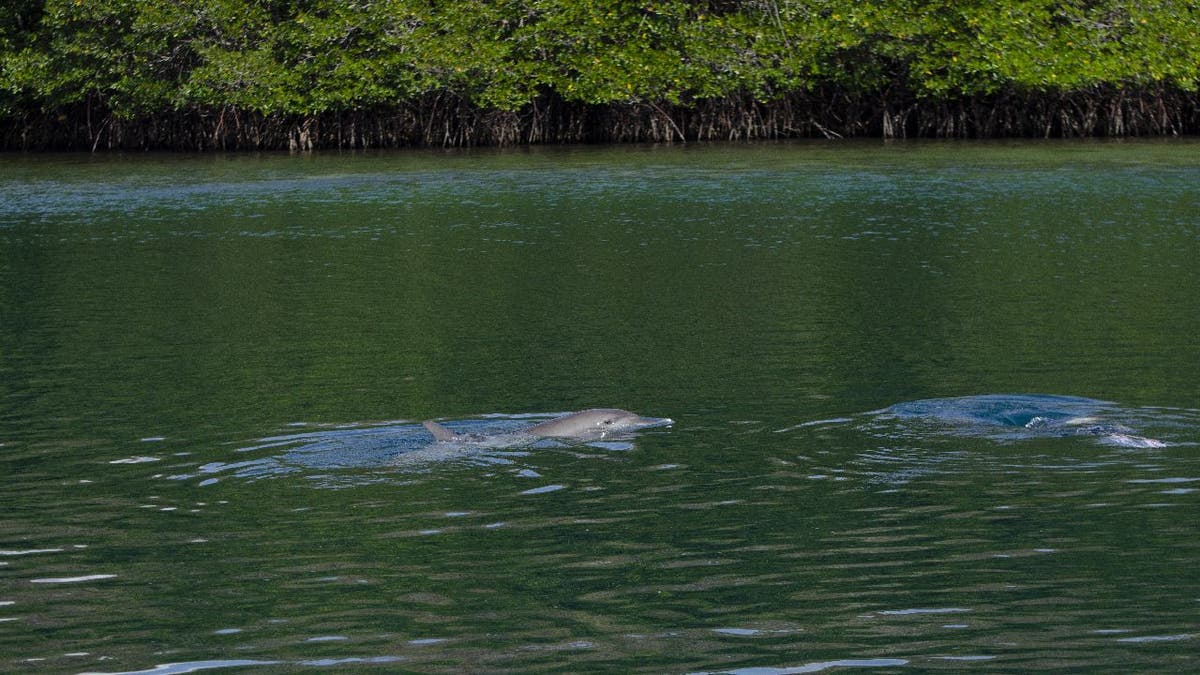Dolphin captured on video swimming in Connecticut river
The dolphin was first spotted Thursday by fishermen along the Thames River Credit: Tashara Elliott
Three bottlenose dolphins that were rescued from a resort hotel in Indonesia in 2019 are now swimming free — after they were rehabilitated by a specialized animal sanctuary.
The dolphin trio — Johnny, Rocky and Rambo — were rescued by the Umah Lumba Rehabilitation, Release and Retirement Center.
It's a dolphin care facility that the Indonesian government set up in Banyuwedang Bay, West Bali, according to the Associated Press.
SICK DOLPHIN WITH 'LOW' CHANCE OF SURVIVAL NURSED BACK TO HEALTH IN THAILAND
Indonesia’s Bali Forestry Department and Ministry of Forestry are the two nature conservation agencies that started the rehab center, according to Ric O'Barry's Dolphin Project, a Santa Monica-based nonprofit that partnered with the initiative.
Umah lumba is the Balinese word for dolphin, according to the Dolphin Project.

In this photo released by Ric O'Barry's Dolphin Project on Saturday, Sept. 3, 2022, rescued bottlenose dolphin Rocky — equipped with a GPS tag — swam through the Umah Lumba Rehabilitation, Release and Retirement Center in Banyuwedang Bay, West Bali, Indonesia. (DolphinProject.com via AP)
The Umah Lumba Rehabilitation, Release and Retirement Center takes in dolphins that have been retired from performances.
Johnny, Rocky and Rambo were set free in Banyuwedang Bay on Saturday, Sept. 3, after three years of care by the rehab center — which receives labor from the Jakarta Animal Aid Network as well as financial support and supervision from the Dolphin Project.
DOLPHINS USE CORAL REEF TO TREAT SKIN CONDITIONS, STUDY SUGGESTS
"It was an incredibly emotional experience to see them go," said Lincoln O’Barry, an animal rights activist and campaigns coordinator at the Dolphin Project, in an interview with the Associated Press.

Animal rights activists and filmmakers Lincoln O'Barry (left) and Ric O'Barry (right) work to protect dolphins around the globe through Ric O'Barry's Dolphin Project, a nonprofit focused on dolphin welfare. (Barry King/WireImage)
O’Barry, 50, is the son of Ric O’Barry, 82, who started the Dolphin Project in 1970 after seeing the toll that show business took on dolphins.
In the 1960s, Ric O'Barry trained dolphins on the set of "Flipper," a TV show that lasted for three seasons.
RARE WHITE DOLPHIN SEEN IN FLORIDA CANAL
Ric O'Barry then shifted his career from dolphin trainer to "dolphin defender" after the show dolphin named Kathy, "who played Flipper most of the time, died in his arms," according to the Dolphin Project.
The father-and-son O'Barry pair were both in attendance during Johnny, Rocky and Rambo’s release.
The three dolphins were captured in Indonesia and spent years performing in traveling circuses until they ended up in a small, chlorinated swimming pool at a resort hotel in North Bali, according to the Dolphin Project.
"Day after day, [they were] forced to perform for paying tourists during loud theatrical shows," the Dolphin Project wrote in a press announcement for the Umah Lumba Rehabilitation, Release and Retirement Center in 2020.
During their captivity, the three dolphins sustained injuries, the Dolphin Project reported.
FLORIDA MANATEE DEATHS DECLINE, BUT STARVATION THREAT LOOMS: REPORT
Johnny, the eldest of the group, experienced skin damage, a pectoral fin injury, a cornea injury, malnourishment and worn-down teeth that went below his gum line.
This summer, Johnny received dental crowns that allow him to catch his own fish.
Rocky and Rambo reportedly gained weight and strength during their rehabilitation, according to the Dolphin Project.
CLICK HERE TO GET THE FOX NEWS APP
When the Umah Lumba Rehabilitation, Release and Retirement Center opened their underwater gates to free the three dolphins, Johnny, Rocky and Rambo did not immediately leave, the Associated Press reported.
It reportedly took about an hour for the dolphins to venture out into Banyuwedang Bay.
Johnny was the first to leave, according to the Associated Press.

On Sat., Sept. 3, 2022, Indonesian Environment and Forestry Minister Siti Nurbaya Bakar (center) opened the gates to release three rescued dolphins — Rocky, Rambo and Johnny — from a dolphin sanctuary. The dolphins were freed in Banyuwedang Bay, located in West Bali, Indonesia. (DolphinProject.com via AP)
The three dolphins reportedly circled the sanctuary that freed them before they departed the area.
FOLLOW US ON FACEBOOK FOR MORE FOX LIFESTYLE NEWS
"They turned back around and came back to us one more time, almost to say thank you and goodbye," said Lincoln O’Barry, in a statement. "And then they headed straight out to open ocean and disappeared."
The Umah Lumba Rehabilitation, Release and Retirement Center will monitor Johnny, Rocky and Rambo through GPS tracking, the news agency reported.
"Where they head next, we don’t know," O’Barry told the AP. "But we wish them a good long life."

In this photo released by Ric O'Barry's Dolphin Project on Saturday, Sept. 3, 2022, rescued bottlenose dolphin Johnny swam to the surface of Banyuwedang Bay after he was released from the Umah Lumba Rehabilitation, Release and Retirement Center in West Bali, Indonesia. (DolphinProject.com via AP)
The World Wildlife Fund estimates that the global bottlenose dolphin population is around 600,000.
CLICK HERE TO SIGN UP FOR OUR LIFESTYLE NEWSLETTER
"Dolphins live off fish, and they work cooperatively to herd their prey to the surface for easier feeding," the WWF wrote in a common bottlenose dolphin profile.
"Because they live so close to the shore, they are threatened by bycatch, coastal development and environmental degradation."
The Associated Press contributed reporting to this article.


